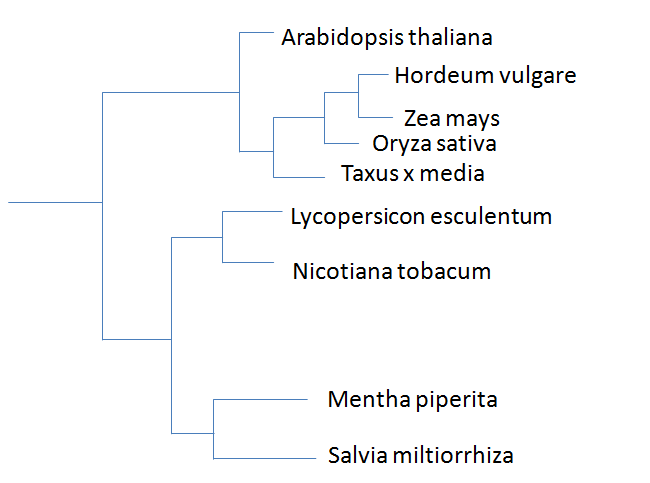The Nitty-Gritty
Classifying organisms is no easy chore. There always seems to be some exception to the rule. Nonetheless, Mentha piperita is classified as follows:
Domain Eukayra
Kingdom Plantae
Phylum Magnoliophyta
Class Magnoliopsida
Order Lamiales
Family Lamiaceae
Genus Mentha
Species piperita
Now that you are thoroughly lost in scientific jargon, let's take a closer look at what these categories mean and why the peppermint species belongs there.
DomainThe domain is the broadest way to categorize an organism, better known as its highest taxonomic rank. An organism can fall into one of three domains: the Eubacteria, the Archaea, or the Eukarya. Because Mentha piperita contains cells that have a true nucleus and organelles that are membrane bound, we are able to classify it as an eukaryotic species. Within the group Eukarya, there are five supergroups that further divide and classify organisms: Excavata, Chromalveolata, Rhizaria, Archeaplastida, and Unikonta. Peppermint belongs to the supergroup Archeaplastida and is explained further in the subcategory, Kingdom.
Kingdom
Mentha piperita is a member of kingdom Plantae; a division of the supergroup Archeaplastida. It is placed in this group
due to the fact that all members of the kingdom Plantae are
multicellular, contain cellulose, and undergo photosynthesis as a
primary means of acquiring glucose. Cellulose is the primary component in plant cell walls and is the chief characteristic that
separates plants from kingdom Fungi whose members have cell walls
made of chitin.
Phylum
After being categorized as a member of the kingdom Plantae, Mentha piperita
is then grouped into one of twelve plant phyla. Due to the
fact that this species is a flowering plant that produces seeds, Mentha Piperita is deemed to be in the phylum Magnoliophyta.
Another defining characteristic of this phylum is their ability to
produce endosperm, a nutritional starch that nourishes the embryo.
Though endosperm may sound like a foreign concept to you, it is more
common than you may realize. For example, in the summer while
you're enjoying some corn on the cob, you are actually consuming the
endosperm of the
Zea mays (sweet corn) species!
Class
Now that we know which phylum Mentha piperita belongs to, we
can then separate it into a class; specifically the Magnoliopsida
class. This class consists of about 170,000 organisms that are
more commonly known as the dicotyledons. The dicots are a
group of plants that display visual characteristics such as having a
net-like veins in their leaves (as seen in the picture below), have petals in multiples of four or
five, and have a taproot or a main root versus having a branching
system.
Order
At the taxonomic level of order, the categorizing characteristics of organisms
becomes much more specific. Like other members of the order Lamiales, Mentha piperita has a
superior ovary composed to two fused carpals. This basically means that
the petals of the flower generally face in an upwards direction rather than
droop down towards the ground. This order also includes those plants which
have five petals that fuse to form a tube at their base. Other organisms
that share this order with peppermint include
carrots, the
shoeblackplant (more commonly known as a
hibiscus flower) and
tea!
Family
In the order Lamiales, there are twenty families. The mint family,
Lamiaceae, is where Mentha piperita falls. This family was
originally known as labiatae, due to the fact that its members have petals that
are fused into, what looks like, an upper and lower lip. Other
characteristics of this family include the presence of a stem that is generally
square when cross-sectioned and leaves that emerge opposite one another.
Salvia, an aromatic and sometimes hallucinogenic herb, also shares this family
with peppermint.
Genus
The second-most specific taxonomic ranking is the genus. In
the genus Mentha, a collection of perennial herbs that are very
aromatic. Due to the incredibly specific requirements that a
genus entails, there is a lot of disagreement between biologist
about which other organisms belong in the genus Mentha.
Species
Finally, we arrive at the species level of classification. It
is here that we are left with one single "flavor" of organism.
At one time, there was considered to be 3000 different species of
mint plants, with 95% of them being illegitimate species. That
number has since been reduced and now includes 18 unique species and
11 hybrid species, Mentha piperita being one of those hybrids.
To learn more about where M. piperita lives, check out the
habitat page!

Or, go back home.

